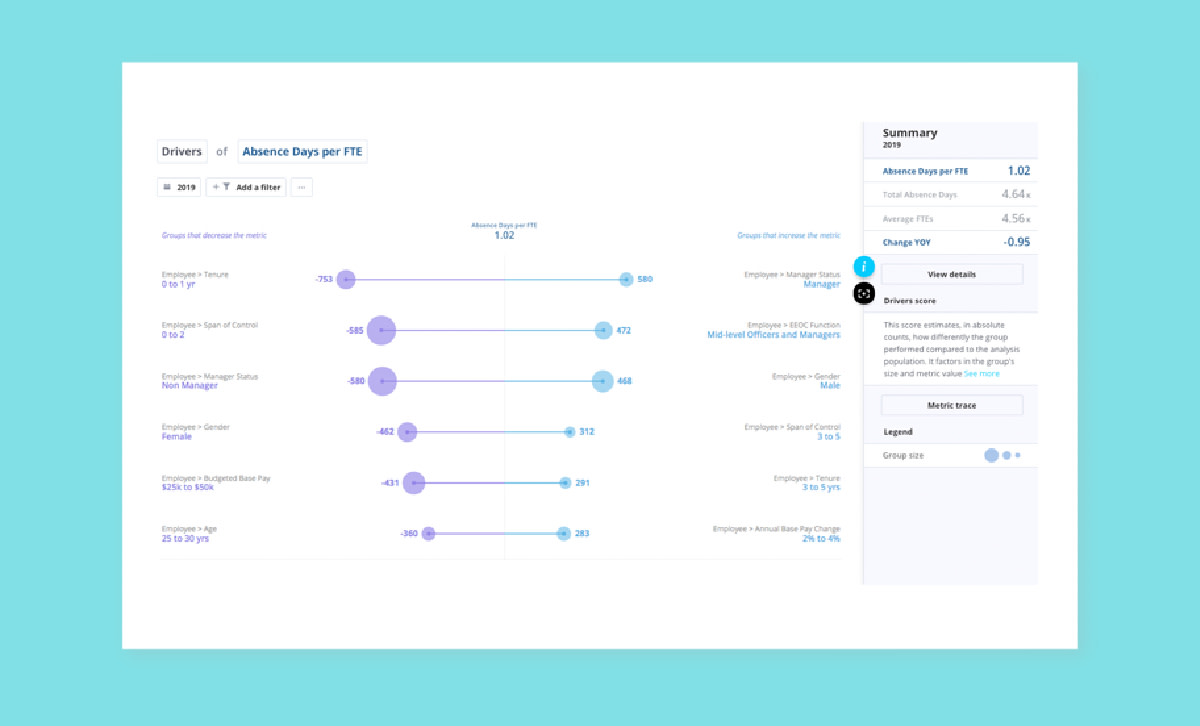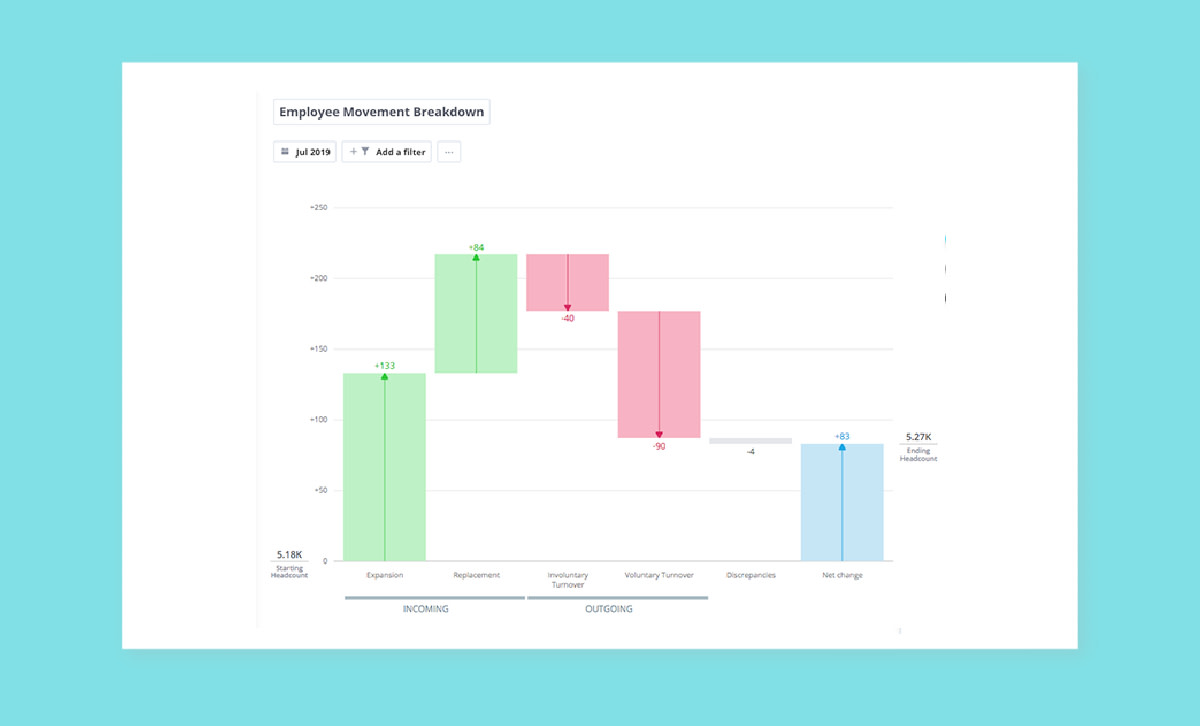How to Turn Your Vision for Data-Driven HR into a Reality
If you are a people analytics champion, you need to build a business case for data-driven HR that is compelling and complete. Here's how.

Many HR professionals are bombarded with blog posts and emails reminding them that if they don’t do something about people analytics, then they are missing out. It shows up in every trend report and “prediction” newsletter. According to Deloitte’s 2018 Global Human Capital Trends study, 84% of HR and business leaders view people analytics as important or very important.
But if so many people think analytics is so important, then why do business leaders struggle to find the time and money to properly invest in this capability? Why do organizations move slowly rather than prioritize it over other investments?
There are two primary reasons for this:
It’s a net new capability for HR: In the past, investments in HR technology have been about automating repetitive or record-keeping tasks — “traditional” HR work. People analytics is a net new capability, and it’s hard to place a value on a service HR has never experienced before. There is plenty of precedence for this outside of HR. Consider a CRM solution such as Salesforce. Years ago, it was a “nice-to-have,” but now an executive wouldn’t even think about running the business without it.
It’s a business investment, not an HR investment: The biggest returns from people analytics are not felt within the HR function’s budget (which pays for it). The returns are felt at the enterprise level. This is a tricky issue, as HR investments are typically funded by replacing existing HR technology or liberating HR headcount. The monetary ROI doesn’t come back to HR (even if the strategic capability ROI does).
“People analytics is a net new capability, and it’s hard to place a value on a service HR has never experienced before. There is plenty of precedence for this outside of HR. Consider a CRM solution such as Salesforce. Years ago, it was a “nice-to-have,” but now an executive wouldn’t even think about running the business without it.”
3 Elements of a successful people analytics business case
It takes more than a few Moneyball references (although they don’t hurt) to get buy-in from the C-suite and leaders within HR. Those who are most successful at gaining support for people analytics acknowledge that it can’t be self-funded by HR. Instead, they ask for an investment in the whole business.
If you are a people analytics champion, you need to build a business case that is compelling (appeals to many stakeholders and connects with financial outcomes), complete (covers all the options for delivering analytics), and durable (can compete with investment requests coming from outside HR). Here is how to execute each of these three elements:
1. Align multiple stakeholders
Before you address all the competing interests and tackle the C-Suite, make sure you have all of your HR stakeholders aligned.
Through conversations (and not just a PowerPoint presentation), help HR leaders understand how an analytics capability improves both the efficiency of how work gets done in HR and the efficacy of the advice that HR gives to the business. Here is how this might look for different groups within the HR function:
Diversity: finding the unseen patterns that actually prevent females from entering leadership roles.
Talent Acquisition: gaining push-button visibility across the CRM, ATS and HRIS systems.
HR Operations: getting visibility into historical data or delivering what the HRIS can’t.
Learning: understanding which learning choices actually impact retention or performance.
HRBPs: gaining the ability to support decisions in real-time–without having to wait for another report extract and data validation.
When providing practical, tactical examples, break down the use of analytics to explain how surfacing a new insight will compel a people leader to make better decisions, and how the collective sum of those new outcomes contributes to an overall improvement in business outcomes.

For instance, one of our hospitality customers justified their analytics investment because they wanted to change which candidates got offers from hiring managers. Conventional wisdom led managers to hire people with previous experience in hotels, restaurants, or casinos. Anecdotal evidence, however, showed that people without previous experience stayed longer and performed better.
Backing up this anecdotal evidence and getting people to buck conventional wisdom was hard. HR knew that restaurant managers responded well to the data points that connected to cost and revenue trends. HR wanted to make hiring outcome data easily available so managers could watch the progress of these small decisions move the turnover trend.
The company now uses our people strategy platform to look at the common attributes of people who were quitting and putting the results into the hands of people who can actually change the outcomes.
In addition to tactical examples like the one above, strategic examples are also essential to build your business case. Good strategic examples will emphasize the following:
The personal impact a CHRO needs to make on the business. Acknowledge the frustration around easily delivering compelling people data and defending data accuracy. Paint a vision for providing fact-based, numerical guidance that charts progress against strategic people goals; delivered with the same gravitas as the CFO’s monthly financial reports. (Check out this blog post to learn more.)
The CHRO’s need to influence at scale.
Sending out memos, cascading messages through HRBPs or doing town halls is analog. Real digital HR uses a regular cadence of data sent directly to hiring managers, collapsing the distance between the CHRO and every people leader. The actual moment that changes diversity outcomes, for example, happens long after someone has been on a training course. Putting analytics close to the next hiring or promotion moment shows how an urgent choice connects to an important issue. This is a powerful way for the CHRO to provide advice at scale.

Data visualization of absence days per full time employee
2. Proactively address roadblocks
Buy-in from HR does not guarantee that this investment will be approved or successful. You still have to convince people who steward existing technology and guard data. Many of these people have a vested interest in preventing any change to existing projects, processes, and rules.
It’s important to be humble about your approach and acknowledge that there are many ways to provide the technology and team that delivers analytics.
Get ahead of the issues by showing the relative cost of each approach, the level of content that can make an impact, and the time it takes to get that content into the right people’s hands. Savvy analytics investors frame out all the options from the beginning and focus people on the fastest path to value rather than the politics of sunk costs.
You will encounter several traps along the way. “The ERP system can do this” is a common one. When someone says this, consider telling them the following:
Transaction systems are not built for holistic people analytics. Once we start delivering people insights, managers will start asking better questions. Questions that start with turnover turn into questions about which turnover really impacts our customers. This means going beyond the data available in a single ERP. HR recordkeeping systems are not built for consuming large amounts of business data. They don’t scale to bring in ATS, CRM, and engagement data. And worse, every time we want to answer “better” questions we will have to pay a consultant and do another change order with the vendor.
“Let’s just build a few visualizations on top of the data warehouse” is another trap. Consider making these statements when you encounter it:
How long does it take to build a new visualization? What’s the cost to maintain it? To answer the drill-down question? Most organizations have a queue to add new data sources, cleanse them and answer new questions. And experimentation (answering the wrong question to get to the right question) can be very expensive without a scalable approach. Often data scientists take up 60% of their time with routine reports because the tools are built for experts, not business generalists.
Deployment is not the goal–behavior change is. A platform that comes with pre-built content enables leaders to start gaining insights more quickly so they can collapse the time between implementation and results. Nobody wants to wait nine months to see the first results of a data warehouse project, and then another six to see behavior change in something like employee turnover. Business leaders need insights at the speed of business–we definitely don’t want to wait a year to see always up-to-date data when doing M&A integration.

Data visualization showing employee movement breakdown for top talent in August 2018 at a fictional organization
3. Demonstrate ROI that can compete with other (non-HR) investment priorities
In the end, a people analytics investment needs to pass muster with the CFO, COO, and CEO. And it won’t just be measured against other HR requests–it will be assessed against requests made by sales, operations, and every other department.
This compels you to demonstrate how data-driven people decisions contribute to improved enterprise performance, whether it’s in the form of increased revenue, better employee retention, or enhanced customer satisfaction.
C-suite leaders are looking for “big bets” that can make a meaningful impact in financial performance or can de-risk the execution of a strategy. When communicating with executives, follow these guidelines:
Make sure part of your investment links to one or more meaningful, multi-year financial impacts. Frame your return in the language of investors but show the impact on EPS, EBITDA, NPS, or whatever makes sense for your company.
Don’t shy away from demonstrating a three-year return, as investments that move the needle in a meaningful way might not yield a payback in the first year.
Don’t hang your hat on one simple measure like improving turnover. Connect with business issues specific to a division, product or region. This helps syndicate support beyond HR.
That being said, the notion of a single capability for the enterprise can still be compelling for the CEO and CFO when framed correctly. Nobody will argue that the investment in leadership development, for example, is important. It’s built on the premise that when new behaviors are repeated with enough frequency, they have a big impact.
Consider how, when a professional baseball team hires a batting coach, the focus is on getting one better hit per player per game. When enough players make and sustain these small improvements, the team starts outperforming.
Always reinforce the very simple premise of people analytics: Deliver insights. Get them in the hands of people who will take new actions with those insights. Get people to take new actions with enough frequency to yield a meaningful outcome.
There is nothing more satisfying than seeing an executive’s eyes light up when she sees how small changes here and there can add up to a larger strategic outcome.

Data visualization showing turnover rate vs revenue per store
Get everyone in the right headspace for people analytics
A successful people analytics investment means overcoming three decades of entrenched beliefs about HR investments.
It means shifting away from investments that simply make HR more efficient recordkeepers into funding a capability that delivers insights and predicts outcomes.
It means moving away from classic technology-driven projects with go-live dates to an agile approach that is always consuming new datasets and publishing guidance.
Finally, it means moving from report requests fulfilled by many people and multiple systems to placing analytics into the hands of people who make decisions.
When all this is taken together, it adds up to a solid case for people analytics that demonstrates value –not just for HR–but for the entire business.
Ready to share powerful insights? Download this white paper to find out how to build your business case for people analytics.
Get Outsmart content straight to your inbox
Subscribe to the People Insights Monthly newsletter for actionable insights and stories.
Subscribe now